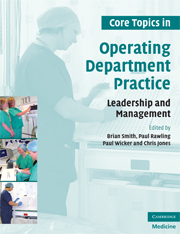Book contents
- Frontmatter
- Contents
- List of contributors
- Foreword
- Preface
- 1 Managing change in perioperative education
- 2 The role of the operating department manager within the context of the organization
- 3 Action learning: a new way of problem solving in perioperative settings
- 4 Agenda for change: what do theatre staff need to know?
- 5 The SWOT analysis: its place in strategic planning in a modern operating department
- 6 Corporate governance: setting the scene for perioperative practice
- 7 Managing different cultures: adversity and diversity in the perioperative environment
- 8 Leadership in perioperative settings: a practical guide
- 9 Management and leadership of advanced practice
- 10 Managing conflict in perioperative settings
- 11 The management and organization of emergency operating lists
- 12 Organizational culture
- 13 Development matters in the NHS; including a perioperative approach to the KSF
- 14 Equipment procurement: a purchaser's guide for theatre managers
- 15 The reflective practitioner in perioperative settings
- 16 New ways of working in perioperative practice
- 17 Damned if you do and damned if you don't: whistle blowing in perioperative practice
- 18 A manager's experience of recruitment and retention
- 19 The management of change
- Index
- References
1 - Managing change in perioperative education
- Frontmatter
- Contents
- List of contributors
- Foreword
- Preface
- 1 Managing change in perioperative education
- 2 The role of the operating department manager within the context of the organization
- 3 Action learning: a new way of problem solving in perioperative settings
- 4 Agenda for change: what do theatre staff need to know?
- 5 The SWOT analysis: its place in strategic planning in a modern operating department
- 6 Corporate governance: setting the scene for perioperative practice
- 7 Managing different cultures: adversity and diversity in the perioperative environment
- 8 Leadership in perioperative settings: a practical guide
- 9 Management and leadership of advanced practice
- 10 Managing conflict in perioperative settings
- 11 The management and organization of emergency operating lists
- 12 Organizational culture
- 13 Development matters in the NHS; including a perioperative approach to the KSF
- 14 Equipment procurement: a purchaser's guide for theatre managers
- 15 The reflective practitioner in perioperative settings
- 16 New ways of working in perioperative practice
- 17 Damned if you do and damned if you don't: whistle blowing in perioperative practice
- 18 A manager's experience of recruitment and retention
- 19 The management of change
- Index
- References
Summary
Key Learning Points
Explore the key milestones in perioperative education
Define some of the conflicts and tensions that occurred
Discuss new ways of teaching and learning in perioperative education
The purpose of this chapter is to highlight the confusion, conflicts and challenges faced by many academic staff and staff involved with perioperative education. To appreciate the changes that have occurred, this chapter will navigate through the key milestones in perioperative education, offering an insight into how they have provided a road map of today's perioperative education.
Operating department assistant training
From 1976 and until the 1990s, education for the operating department assistant and the operating department practitioner (ODP) was available through regional training centres. The City and Guilds of London Institute approved the regional training centres following recommendations made by the Lewin Report (Department of Health 1970). This offered many recruits, who came from diverse backgrounds and who did not always have perioperative experience, an opportunity to enter into perioperative practice.
The course itself comprised of two calendar years where the ‘trainee ODA’ was exposed to specialities within the theatre suite. Trainees were also invited to visit other departments that had a direct influence on their perioperative work. For some, visiting accident & emergency, sterile services, coronary care and intensive care units expanded their knowledge and understanding of medicine and healthcare.
- Type
- Chapter
- Information
- Core Topics in Operating Department PracticeLeadership and Management, pp. 1 - 9Publisher: Cambridge University PressPrint publication year: 2009

